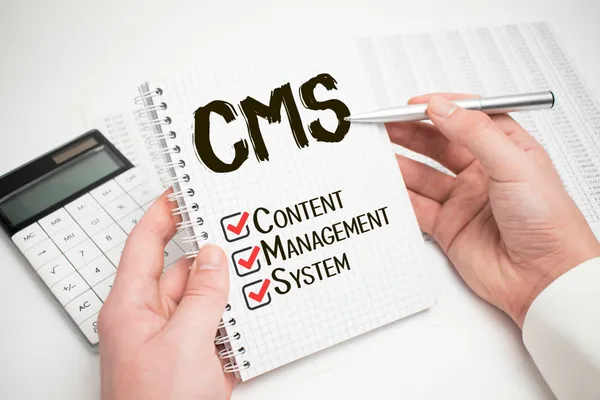If you want to learn how to work effectively on your company's website, the tips on working with CMS (Content Management System) from the post below will definitely help you. After reading this article, you will learn best practices such as: adapting to the audience, planning publications, ensuring security and many others. Thanks to them, the content management system will become an irreplaceable tool in your hands.
Recognizing your target: Why a CMS is crucial to your online strategy
When starting to work with a CMS, the first step is to understand what goals you want to achieve with your website. Whether it's selling products, sharing information, or building a community - each goal requires a different configuration and approach in the CMS. Choosing the right CMS that is flexible and scalable is crucial to meet these goals. Before you start learning CMS best practices, read our article about the most important CMS functions and make sure you have chosen the right tool.
1. Plan and organize publications in CMS
Effective use of a CMS depends largely on careful planning and organization of publications. In the era of constantly flooding us with information, the law applies: stand out or die. The key to this process is establishing a content strategy that takes into account your business goals and the needs of your audience. Thanks to this, your target group may, out of habit, reach for valuable content prepared by you during Saturday breakfast.
Create and manage a content calendar
Creating and managing a content calendar is more than just scheduling publication dates. It is a strategic tool that allows you to effectively manage the entire content lifecycle, from concept to publication. In your content calendar, it is worth taking into account not only specific publication dates, but also the time needed for research, writing, editing and promotion. This gives the team a clear overview of upcoming tasks and can better allocate resources and prioritize work.
Additionally, the content calendar allows you to monitor and analyze the effectiveness of various types of publications. By tracking which content resonates best with your audience, you can adjust your publishing plans to better meet your audience's needs and interests. Such analysis may include indicators such as the number of visits, time spent on the website, conversion rates, as well as social media interactions.
The tools most often used to manage the content creation process may be platforms such as Hive, Asana, Jira or Notion, which allows you to create up to 10 free user accounts. It is important to remember to set the appropriate publication date when adding a new post to the content management system. Thanks to this, we will be free from worries about keeping an eye on publication deadlines and we will be able to start creating new valuable content.
Establish uniform tagging and naming rules
The second important aspect of organizing content in a CMS is establishing uniform rules for tagging and naming. Consistent use of tags and categories makes it easier for both users and search engines to navigate and find content. Moreover, a well-thought-out naming and tagging system makes it easier to group content and analyze its effectiveness.
Version control
Version control in a content management system is the third key element for effective teamwork and content change management. It allows you to track the editing history, which is especially important when multiple authors work on the content. With this feature, you can easily undo unwanted changes and ensure that all updates are thoroughly documented, increasing transparency and accountability in the creative process.
In situations where content is accidentally deleted or overwritten, version control acts as a recovery mechanism. This ensures security and allows you to restore previous versions of documents, which is invaluable for regular updates on large portals or websites. Version control is an essential tool for anyone who wants to effectively manage the dynamic process of creating and updating content.
2. Monitor and maintain content quality
Monitoring and maintaining content quality are integral parts of working with a CMS. In a rapidly changing digital world, it is essential to review and update content regularly to ensure that information remains current, accurate and relevant to your audience. Taking care of the quality of your content not only increases the value you offer to users, but also strengthens your website's position in search results.
Regular content review
Regular content review is a basic step in maintaining high-quality content in the CMS. This process involves evaluating older articles, blogs, and other materials to ensure they are current, accurate, and aligned with current trends and business goals. Regular reviews also allow you to identify content that requires refreshing or removal, which is important for keeping the website clean and tidy. Of course, we don't have to do it manually.
The implementation of content monitoring and maintenance systems allows for continuous assessment of the effectiveness of published materials. Analytical tools such as Google Analytics can provide valuable information about user behaviour, the popularity of individual pages and how they interact with content. Analyzing this data allows you to optimize your content to increase user engagement and improve SEO metrics.
There are also tools available on the market that monitor our website's position in search results. This applies not only to the home page, but also to all indexed subpages. Thanks to these tools, we can see not only which place we are in, but also how difficult it will be for us to jump to a higher place. Examples of such tools are: Semrush, SurferSEO and Ahrefs.
Therefore, remember that monitoring and maintaining the quality of content in your CMS is essential for anyone who wants to not only attract, but also retain the attention of their audience and achieve better results in search engines.
3. Use external tools and resources when working with CMS
Effective content management in a CMS system requires more than just knowledge of basic functions. To fully utilize the potential of your CMS platform, it is essential to integrate the right external tools and resources. Here's how you can do it.
Choosing the right CMS system
Choosing a CMS system is not just a matter of preference. This is a decision that should be dictated by the specific needs of your business. Consider whether you need an easy-to-use tool like Strapi or systems such as WordPress, Drupal, Joomla. It's important that your choice supports both current and future business goals and allows for integration with other tools.
It is also worth considering choosing CMS systems based on open source software. Such solutions offer greater flexibility and the ability to adapt to individual needs. Thanks to open source, even if a specific integration or functionality is missing, you can outsource its development to external developers. This makes open source systems an ideal solution for those who want to have full control over their platform and adapt it precisely to their needs.
Integrated Analytical and SEO Tools
Understanding the behaviors and needs of your audience is key. Use analytics tools like Google Analytics to track your website traffic and understand how users interact with your content. Also integrate SEO plugins to optimize your content for search engines, which will increase the visibility of your website.
Metadata and Structured Data configuration for SEO
In the context of SEO, metadata configuration is essential. Focus on optimizing your page titles, meta descriptions, and header tags, which are key elements that influence SEO. Good SEO practices require that titles and descriptions be concise but descriptive and include your main keywords.
It is also worth paying attention to structured data, which helps search engines better understand the context and content of your website. This allows your website to be more visible in search results, for example by displaying rich snippets. Tools such as Google's Structured Data Testing Tool will help you check and verify the correctness of your structured data configuration.
Tools for checking the quality of SEO configurations
Regularly using third-party tools to check the quality of your SEO setup is important to ensure your SEO practices are top-notch. Tools such as Semrush, Moz Pro and Ahrefs offer wide functionalities, including keyword analysis, position monitoring, and review and analysis of SEO errors on your website. Using these tools allows you to continuously optimize and adapt your SEO strategy to changing search engine algorithms.
Additional resources and support
Additionally, it is worth investing in training and educational materials on content management and SEO optimization to constantly develop your skills and stay up to date with the latest trends. Access to user communities and discussion forums related to your chosen CMS can also provide valuable support and knowledge exchange.
With the right tools and resources, working with a CMS becomes much simpler and more effective, which translates into better quality of content, greater user engagement and better positioning in search engines.
4. Create a quality-oriented culture when working with CMS
Building a quality-oriented culture when working with content management systems (CMS) is crucial to the long-term success of any web project.
Promoting a culture of quality and continuous content improvement
Implementing a culture of quality when working with a CMS begins with understanding that each element of content affects the overall perception of the website by users and search engines. This means consistently striving to create valuable, accurate and engaging content. Regular training of the team in SEO best practices, content writing and UX design is key here. It is also important to encourage continuous development and experimentation so that the content is not only informative but also innovative.
A quality culture in CMS work should also promote regular evaluation and updating of existing content. This includes quality reviews, analysis of data from analytical tools, and content updates in response to changing search engine trends and algorithms. This culture fosters the creation of content that is not only up-to-date, but also optimized for the latest SEO practices.
Commitment to creating a quality-oriented culture in working with CMS contributes to building a strong, credible and valued online presence by users. It's an approach that brings benefits in both the short and long term, helping to build lasting trust and loyalty among users.
5. Track Trends and Measure Results
Effective use of a content management system (CMS) requires not only ongoing monitoring of industry trends, but also regular measurement of the results of your activities. Adapting your content strategy to evolving user needs and changing search behavior is crucial to maintaining a competitive and effective online presence.
Responding to current trends in content management
Keeping your website up to date with the latest trends, such as the rise of video content, podcasts and interactive formats, is important for increasing engagement and reach. Experiment with new formats and content presentation techniques to better meet user expectations and preferences. Trends such as the increasing use of artificial intelligence in content creation and the development of AR/VR technology may open up new opportunities for the development of your website.
Measuring the effectiveness of activities in CMS
Effective content optimization and SEO strategy require deep analysis of the results. Using tools such as Google Analytics, perform a detailed analysis of user behavior on the website, the effectiveness of individual content and achieved conversion goals. Pay close attention to metrics like bounce rate, time on page, and conversion rates to identify areas for improvement and adjust your content strategy.
Proactively adapt to Trends and Results
Consistent tracking of trends and analysis of results are necessary to create dynamic and engaging content that responds to current market needs and user expectations. Be proactive in adapting to new trends and be ready to quickly change your content strategy to keep your site ahead of the competition.
Case studies and trend analysis
Enrich your content strategies by gaining knowledge from case studies and trend analyses. Examples of companies that have effectively responded to changing trends can serve as inspiration and guidance for creating more effective content. Regularly review industry reports and analysis to stay up to date with the latest strategies and best practices.
6. Understanding Audiences and Their Needs in the CMS Context
To maximize the effectiveness of your content management system (CMS), it is crucial to thoroughly understand your audience and their needs. It is not only about identifying the target group, but above all about understanding their unique characteristics, interests and challenges they face.
Detailed Analysis of the Target Group
The first step is to conduct a detailed analysis of your audience. Use available demographic data, online behavior analytics and direct feedback to understand who your users are. Ask questions like: What are their main interests? What problems are they trying to solve?
Adapting Content to Users Needs
Based on the information collected, adjust your content to best meet the needs and expectations of your target group. Remember that content that resonates with your audience not only attracts their attention, but also builds trust and loyalty. Use the language and tone of communication that best suits your target group, and experiment with different formats and styles of content presentation.
Feedback Tracking and Strategy Adaptation
Regularly monitor users' reactions and interactions with your content. Analytical tools and direct feedback are an invaluable source of information, allowing you to constantly adjust and improve your content. Be open to changing and adapting your strategy based on the information obtained.
Setting Goals According to Your Audience's Needs
Set specific goals for your content that meet the specific needs of your audience. Whether it's education, entertainment, or solving specific problems, make sure your goals are clearly defined and in line with your audience's expectations.
Creating content tailored to your target group
To maximize the potential of a CMS, it is crucial to create content tailored to your target group. This not only means writing about topics that interest them, but also adapting the language, tone, and format to suit their preferences. Analyzing demographic data, online behavior and user feedback can give you valuable tips on how to best engage your audience. Remember that the most effective content is one that not only attracts attention, but also builds lasting relationships with recipients.

Adam Naworski



